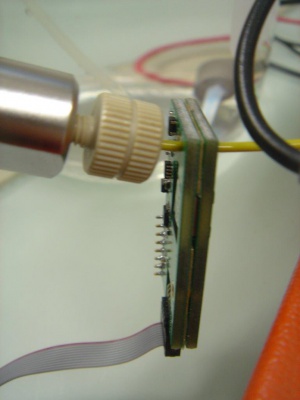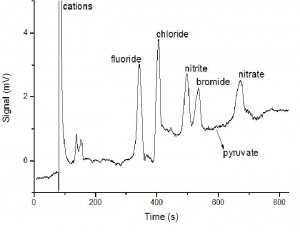Difference between revisions of "ET125ヘッドステージを用いたC4Dイオンクロマトグラフィー"
| Line 6: | Line 6: | ||
== '''はじめに''' == | == '''はじめに''' == | ||
| − | + | eDAQ [http://www.edaq.com/ET125 ET125 C4D チューブヘッドステージ] は、イオンクロマトグラフィー(IC)や高速液体 | |
| + | クロマトグラフィー(HPLC)用の非接触電導度検出器とし | ||
| + | て開発されました。 It is designed to connect directly to tubing sizes 1/8 inch (3.2 mm) OD or less (the users specifies the OD when ordering the product). For example, the 1/16th inch (1.6 mm) outer diameter headstage connects directly to the standard for tubing for IC and HPLC. | ||
Connecting the detector immediately after the separation column, as shown in Figure 1, greatly reduces extra-column band broadening (remixing of the analytes after the column) because the “dead volume” is reduced. | Connecting the detector immediately after the separation column, as shown in Figure 1, greatly reduces extra-column band broadening (remixing of the analytes after the column) because the “dead volume” is reduced. | ||
Revision as of 15:21, 27 February 2014
DAQ C4D システムをイオンクロマトグラフィー/HPLC 用の 1/16" 径チューブに直接つなぎ、6種類の陰イオンを 分析します
はじめに
eDAQ ET125 C4D チューブヘッドステージ は、イオンクロマトグラフィー(IC)や高速液体 クロマトグラフィー(HPLC)用の非接触電導度検出器とし て開発されました。 It is designed to connect directly to tubing sizes 1/8 inch (3.2 mm) OD or less (the users specifies the OD when ordering the product). For example, the 1/16th inch (1.6 mm) outer diameter headstage connects directly to the standard for tubing for IC and HPLC.
Connecting the detector immediately after the separation column, as shown in Figure 1, greatly reduces extra-column band broadening (remixing of the analytes after the column) because the “dead volume” is reduced.
A sample containing 1 mM fluoride, chloride, nitrate, bromide, pyruvate and nitrate was analysed; the chromatogram is shown in Figure 2.
The method used was similar to experiments previously published, except contactless (as opposed to contact) conductivity detection was used: Separation of anions by ion-interaction chromatography with a novel cationic/zwitterionic eluent; Zhu Yan, Ling Yanyan, James S. Fritz, Paul R. Haddad; Journal of Chromatography A, 1020 (2003) 259–264
Equipment Required
- C4D hardware unit, either:
- ER225 C4D Data System including PowerChrom software
- ER815 C4D Detector with third-party data acquisition system
- ET125 General Purpose C4D Headstage
- HPLC instrument
Conditions
- Sample: A solution of 1 mM fluoride, chloride, nitrate, bromide, pyruvate and nitrate, dissolved in water.
- Buffer: 98.75% water, 1.25% methanol, 2.5mM tetrabutylammonium hydroxide (TBAOH) and 5mM 3-(N-morpholino)-propane sulfonic acid (MOPS).
- Separation column: Macherey-Nagel, Nucleosil 120.5 C18, part 720041.46.
- C4D settings
- frequency = 800 kHz
- amplitude = 80 A
- headstage gain OFF.
- Data recording:
- lowpass Filter = 10 Hz
- range = 20 mV
- sampling rate = 1000 data points per second.

